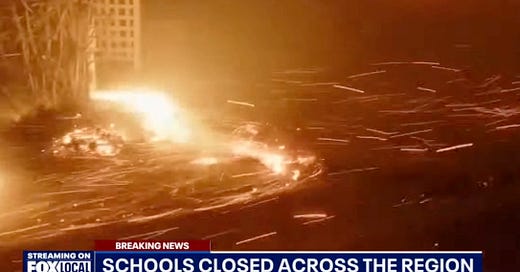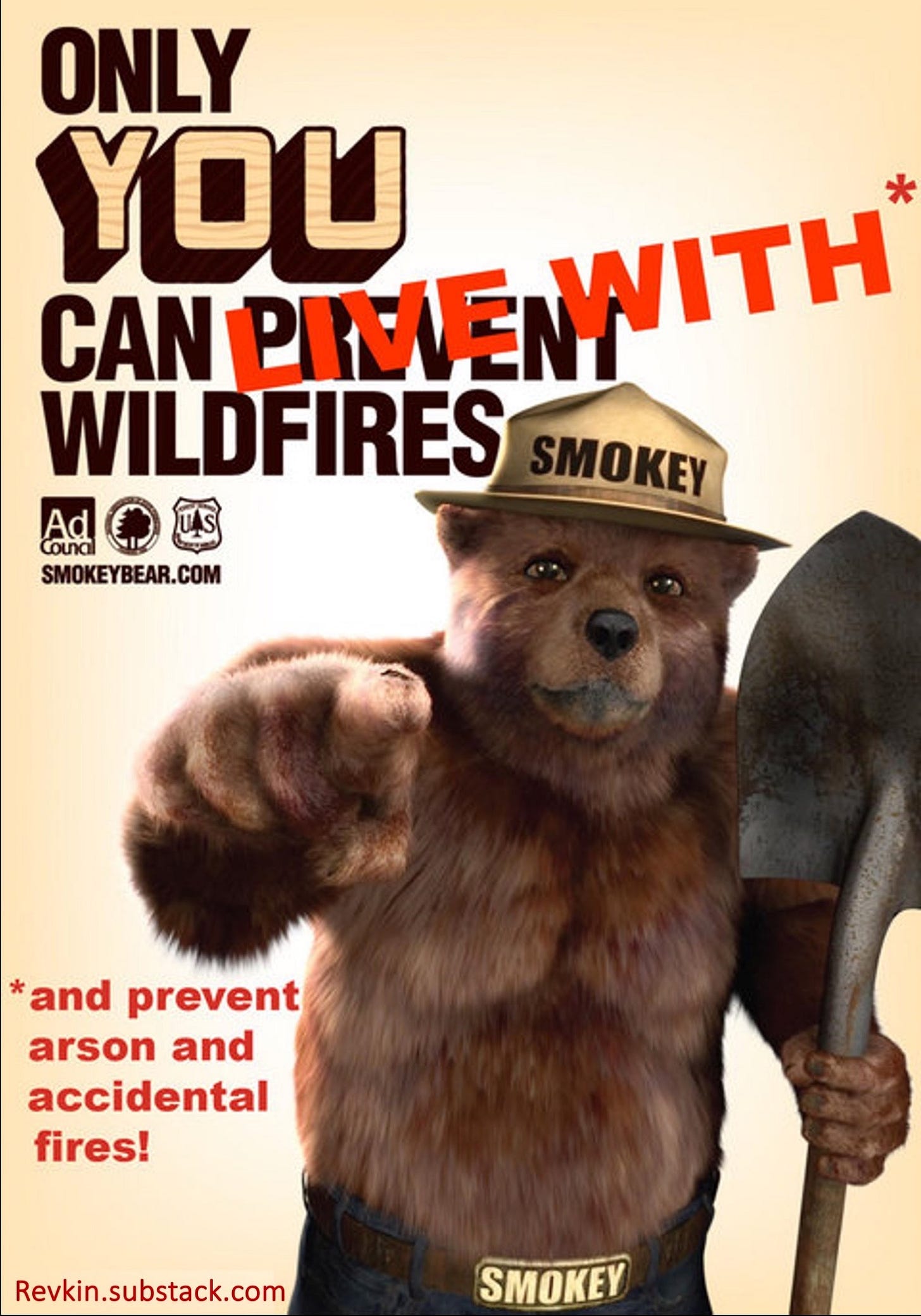Once again, American communities (like others from Australia to Greece and Portugal) are facing calamitous impacts from wildfires that started in brush or forests and exploded as embers carried on ferocious gusts literally spark extreme urban fires firestorms.1
Think back to Lahaina, Hawaii; Superior, Colorado; Santa Rosa, California. I can keep going… Scroll to the bottom of the post for my dispatches on these previous catastrophes.
Now add Pacific Palisades, Pasadena, and other Southern California communities scorched or threateneed by the still-spreading fires around the greater Los Angeles metro region. The Los Angeles Times has dropped its paywall for live coverage and that’s a good way to get the latest, including the first reports of deaths.
I snipped this clip from one of the AlertCalifornia fire-monitoring webcams last night. The speed of spread is insane (but not unprecedented).
This post is not for the tens of thousands of people facing realtime danger to lives or property. They should be tuned in to local and state agencies and local news media doing nonstop coverage, as I stressed on social media.
Such extreme firest firestorms erupt when abundant wildland fuels are parched by heat and drought, swept by winds, and ignited (still mostly by human activities). Once they are up and running the abundance of burnable fuel in their path is the key. The fuel in homes doesn’t have to be part of the equation if they and the lands around them are properly designed and managed (more on that below).
Why January extreme fires firestorms?
On his YouTube channel, Daniel Swain, a must-follow UCLA weather and climate scientist focused on California’s inherent extreme wet/dry swings and the global warming context, described the conditions as an “atmospheric blow drier” with several days of extreme fire-weather danger still to come. He said there’s no evidence climate change is changing, or will change, California’s fabled Santa Ana winds, but there is evidence CO2-driven warming is shifting wet/dry patterns so dry conditions can line up more frequently with the seasonal gales. (Hat tip Andrew Freedman at Axios.)
One thing is clear and welcome. On his livestream today, Swain noted these fires were “an exceptionally predictable event,” and that, almost assured, has kept down the death count.
It’s the embers more than the fire
Here’s a snippet from an excellent livestreaming Fox 11 report on the region’s continuing fire emergency showing a critical component that transforms wildland fires into urban threats - ember storms:
I’m on the run but want to be sure anyone in a community where brush, forests and homes and businesses intermingle takes this disaster as a checkup moment.
Embers can find weak spots in any home and that’s how homes burn and, in a cascade, can add embers to wind-spreaad conflagrations. [Insert 1/9>] Decorative plantings add to the cascade. Non-native palms (which you can see ablaze in many news reports) are particularly loathed by firefighters and fire experts I’ve interviewed.
This clip from a 2016 Dot Earth post says heaps (video was YouTube via “Fire Lensman.”) [<end Insert]
Click the links below to see other examples.
Here are resources that are a vital guide for anyone who lives anywhere a fire can start out of town and spread into it.
Watch this great and sobering video from the National Fire Protection Association showing “ how your house can survive a wildfire,” narrated by Jack Cohen, who just retired after decades of important research and experimentation on cutting risks at the wild-built interface. It’s all about keeping embers out.
Watch “Elemental,” a documentary (streaming in lots of places) aimed at flipping community conversations from fighting fire to living with it.
Watch the great U.S. Geological Survey film "Living with Fire." (I’ve referred to it before.) Its focus is southern California, where the dominant fire-shaped chaparral ecosystem is profoundly different from the forests of the Sierra Nevada. But again, this line from Survey fire scientist Jon Keeley should resonate everywhere: “Nobody talks about trying to stop earthquakes. Wildfires require the same kind of approach.”
My post on the Lahaina fire
Lessons for Everyone from Hawaii's Lahaina Firestorm Tragedy
UPDATED 8/24 - Watch and share this Sustain What episode on building “firewise” futures after this summer of combustion. It was full of invaluable insights contributed by several great guides to reducing wildfire risk facing landscape change, climate change and community inertia. Watch on YouTube below,
My post on Boulder County, Colorado’s urban firestorms sparked by grassland fires and hurricane winds
When Wildfire Comes to Town – Amid the Marshall Fire’s Urban Ashes, Hints of a Less Combustible Future
To keep track of Colorado fire impacts and help families who lost homes, visit the Boulder Office of Emergency Management website and Colorado Responds.
My post on lessons from the Tubbs fire
Building Forward Safer Where Communities Grow Into Wildfire Danger Zones
Click here to subscribe to my Sustain What dispatch. Community resilience is a core theme.
Fire terminology correction
A scientist focused on fire and climate, Jonathan Vigh (see my interview with him about the horrific wind-driven fires near Boulder Colorado), sent in a cautionary note about avoiding misapplication of the term “firestorm”:
I appreciate your coverage of the LA fires, but please do not call the LA fires "firestorms". It is scientifically inaccurate to use that term for these downslope windstorm-driven events, for reasons which I briefly explained toward the end of the seminar-style presentation that I gave a couple months after the Marshall Fire.
17 Feb 2022: Observations on the Marshall Fire: A survivor's perspective, MMM Weekly Chat, Mesoscale and Microscale Meteorology Laboratory, National Center for Atmospheric Research (NCAR), Boulder, CO (video and slides):
https://drive.google.com/file/d/1T8CB2ErUhQMh6z0hM6phz7alDEUBYz4z/view
I believe it's really important to not misuse the term firestorm because if and when we ever do have an actual firestorm (which is certainly possible under the right conditions, but conditions which generally differ from those of downslope wind-driven events), it will be a whole different level of devastation. A key difference is that a firestorm will likely kill hundreds or thousands of people, whereas downslope wind-driven events like this generally give people enough time to get away (Lahaina excepted).
Best regards,
Jonathan
Parting shot - the Smokey Bear we need
I mad this image back in my New York Times Dot Earth days…









Key quote: "One thing is clear and welcome. On his livestream today, Swain noted these fires were “an exceptionally predictable event,” and that, almost assured, has kept down the death count".
The people, technology, and science behind the warnings of events like this are often not given their due because the number of lives that weren't lost is not calculable. It's still early, but at least from what I've seen on TV so far, virtually everyone interviewed was aware of the danger in advance and was generally prepared.
Andy, from the ashy knolls of Santa Monica, thanks for this. It's a great point, about changing the mindset of fighting fires to living with them as quite literally forces of nature. Thanks for your helpful post.